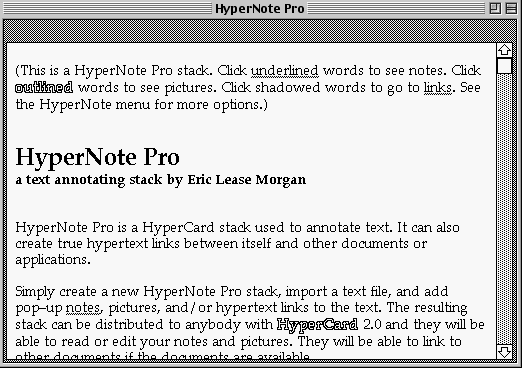In 1992 I wrote a HyperCard stack called HyperNote Pro.
 HyperNote allowed you to annotate plain text files, and it really was a hypertext system. Import a plain text file. Click a word to see a note. Option-click a word to create a note. Shift-click a word to create an image note. Option-shift-click a word to link to another document. Use the HyperNote > New HypernNote menu option to duplicate the stack and create a new HyperNote document.
HyperNote allowed you to annotate plain text files, and it really was a hypertext system. Import a plain text file. Click a word to see a note. Option-click a word to create a note. Shift-click a word to create an image note. Option-shift-click a word to link to another document. Use the HyperNote > New HypernNote menu option to duplicate the stack and create a new HyperNote document.
HyperCard is all but dead, and need an older Macintosh computer to use the application. It was pretty cool. You can download it from my archives. Here is the text from the self-extracting archive:
HyperNote Pro: a text annotating stack by Eric Lease Morgan
HyperNote Pro is a HyperCard stack used to annotate text. It can also create true hypertext links between itself and other documents or applications.
Simply create a new HyperNote Pro stack, import a text file, and add pop–up notes, pictures, and/or hypertext links to the text. The resulting stack can be distributed to anybody with HyperCard 2.0 and they will be able to read or edit your notes and pictures. They will be able to link to other documents if the documents are available.
Here are some uses for HyperNote Pro. Context sensitive help can be created for applications. News or journal articles could be imported and your opinions added. Business reports could be enhances with graphs. Resumes could go into greater detail without overwhelming the reader. Students could turn in papers and teachers could comment on the text.
Another neat thing about HyperNote Pro is it self–replicating. By selecting “New HN…” and choosing a text–file, HyperNote Pro creates a copy of itself except with the text of the chosen file.
HyperNote Pro is free. It requires HyperCard 2.0 to run.
Features:
- any size text–file can be imported
- format the text with any available font
- add/edit pop–up notes and/or pictures to imported text
- add true hypertext links to any document or application
- includes a “super find” feature
- self–replicating
- System 7 compatible
\ / - * - \ // \ Eric Lease Morgan, Systems Librarian - * -|\ / North Carolina State University / \ - * - Box 7111, Room 2111 | |/ \ Raleigh, NC 29695-7111 \ /| | (919) 515-6182 - * - | / \| / | |/ =========== America Online: EricMorgan \=======/ Compu$erve: 71020,2026 \=====/ Internet: eric_morgan@ncsu.edu ===== The Well: emorgan
P.S. Maybe I will be able to upload this stack to TileStack as seen on Slashdot.
